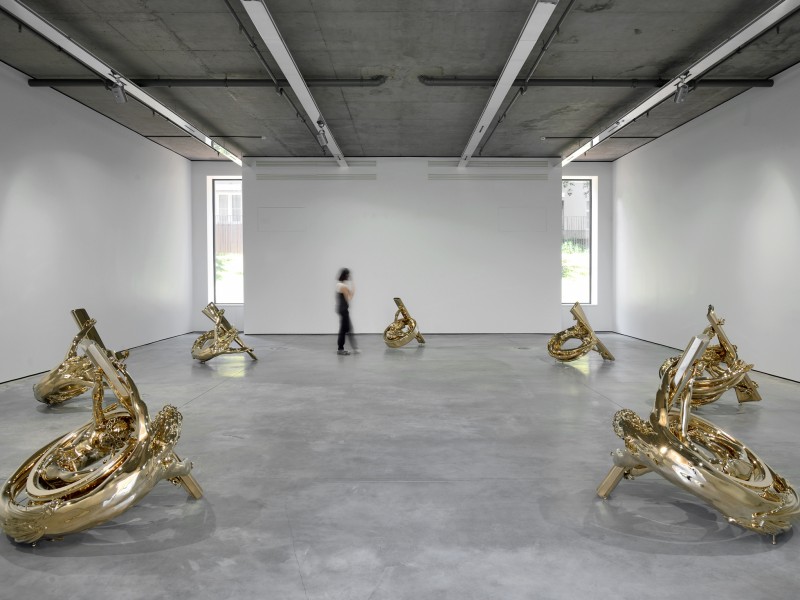“TO TELL YOU THE TRUTH, AND GIORGIO KNOWS THIS, I REALLY DON’T KNOW ANYTHING ABOUT FASHION, AND I KNEW EVEN LESS WHEN WE MADE AMERICAN GIGOLO. BUT IT WAS DARING, FORWARD THINKING DESIGN THAT INFLUENCED A GENERATION OF OTHER DESIGNERS, WEARERS AND WANNABE MOVIE DREAMERS. THE BEST FABRICS IN THE WORLD. AND HE IS A GENTLEMAN.” —RICHARD GERE
It’s a crisp evening in October 2000 and a myriad of celebrities, journalists, clients and friends of the house, are gathered in the Guggenheim Museum in New York City to celebrate a self-titled retrospective of the finest work from fashion designer Giorgio Armani. After an introductory speech downstairs, guests are free to wander through the exhibition at their own leisure, winding through decades of sartorial style and elegance. The event is star studded—Michelle Pfeiffer, Jeremy Irons, Isabella Rossellini and Patti Smith can be seen mingling and admiring Armani’s vast body of work, curated in themes as opposed to chronological decades. As the then-editor of Vogue Australia, I was one of an elite group of journalists flown over for the celebration. As I meandered through the sizable crowd, I oddly found myself alone in a small darkened room off to one side. Projected upon a large screen was a looped clip of the now legendary scene of a bare chested Richard Gere in American Gigolo, laying his jackets, shirts and ties out on the bed, coordinating the colours and textures, singing along to Smokey Robinson. I stood stock still watching in admiration, thinking the inevitable “God, he was hot,” when I heard someone walk in behind me. It was Richard Gere, he too was alone. 20 years after he had filmed that iconic scene, he looked at the screen for a few moments, glanced at me, broke into a wide, slightly embarrassed grin, shrugged his shoulders and quickly turned and walked out of the room. I had just seen Richard Gere watch Richard Gere in American Gigolo, perhaps one of the most seminal fashion moments in the history of cinema. Mind blown.
Giorgio Armani is of course, one of the most successful fashion designers in the world, with a business worth a staggering $6.5 billion net in 2016, according to Bloomberg. Born in 1934, his early years included a stint as window dresser for La Rinascente in Milan, and a period designing menswear in the workrooms of Nino Cerruti before he broke out forming his own label in 1974. His early designs blew an obvious wind of change into a period of restrictive suiting and sharp angles. Armani played with luxurious fabrics, textures, muted tones and unique silhouettes that had their lining removed and which in turn provided fluid pleating for both men and women. But the languid sexiness he brought to suiting was not louche or unformed. The masterful lines were still tough, the slightly exaggerated shoulders and the ‘ready for business’ attitude bringing with it a new sense of power dressing. Women and men across the planet breathed a sigh of delighted relief. They were shown how to send a message of confidence, without constriction or artifice. A new subtlety for a new decade, drawing on impeccable Italian traditions but focused on a modern cosmopolitan future.
While Armani’s new clothes were certainly making an impact in the fashion world, it could be argued that it was the clothes worn by Richard Gere’s character, the male sex worker Julian Kaye in director Paul Schrader’s American Gigolo, that catapulted Armani into the greater universe. This reasonably vacuous fable of the LA hustler with the heart of gold would turn not only Armani, but also Richard Gere, into lifelong superstars. “Giorgio Armani was involved because of John Travolta,” Paul Schrader confirmed in an interview with GQ Magazine. “Travolta was originally going to star and his manager suggested Armani because he knew that he was on the verge of becoming big. We all went to Milan and Giorgio was just getting ready to go into an international non-couture line, so the film synced up perfectly with what he was up to. John dropped out at the last moment and Richard came in, but we kept all the Armani clothes. It was just a matter of tailoring.”
Maybe not. To men around the world, watching Gere working out at home in his grey marle boxer briefs and colour coding his clothes, was more about sexuality and a straight man’s relationship to fashion and style being called into play. “It’s the way that Richard Gere’s character interacts with his clothes that has made American Gigolo a game changer for men’s fashion,” says fashion columnist and menswear expert Damien Woolnough. “The amount of attention he pays to his tie, shirt and suit doesn’t threaten the character’s masculinity. His careful consideration doesn’t just attract women, it also attracts money. Robert Redford and Steve McQueen cultivated images of effortless fashion icons, but in American Gigolo we see the work that goes into looking great.”
Timeless is an overused word in the vocabulary of fashion, but there is no doubt that almost all of the elements of Gere’s wardrobe are just as relevant today. From the classy belted camel trench, relaxed tone on tone suiting and ties combined with a cardigan. Perhaps the best redux in recent times was the DSquared Spring/Summer 2011 American Gigolo inspired show, featuring the slightly high rise, super tight jeans, white shirt sleeves rolled up to reveal perfect biceps. Gere’s polished, understated wardrobe, matched with his raw sexiness, proved to be the winning combination. “Of course it helps that the clothes are Armani and the actor is Richard Gere,” notes Woolnough dryly. “If it had been John Belushi in Fletcher Jones we wouldn’t still be talking about this film.”
The film scenes where Gere spends time contemplating what to wear were considered at the time extremely liberating for the average straight male, indicating that fashion could legitimately be used as a manner of seduction. Famed film critic Roger Ebert had another, less positive take on the underlying message. “The whole movie has a winning sadness about it; take away the story’s sensational aspects and what you have is a study in loneliness. Richard Gere’s performance is central to that effect and some of his scenes—reading the morning paper, rearranging some paintings, selecting a wardrobe—underline the emptiness of his life.” Whatever the cinematic subtext, his Armani wardrobe kick started a sartorial revolution and created a tangible symbol of quiet wealth and power that not only dominated the 1980s, but continues to resonate today.
In 2004, I was again fortunate to spend more time with Mr Armani, this time as a journalist joining him on a week-long tour of Hong Kong and Shanghai. The signature Armani aesthetic was on constant display, worn by both his team and Mr Armani himself—white sneakers, navy cardigans, white shirts and jeans by day, relaxed suiting by night. Although I knew him to be a giant in the fashion world, I was astonished by the extent of his fame—airport crowds would part, heads would turn, world leaders would magically drop by at their tables in restaurants. It struck me then that his importance to both mens and womenswear is what has made him the legend that he is. No fashion designer, perhaps not even Karl Lagerfeld, is as well known or respected as Giorgio Armani. With one film he managed to intrinsically change the way men view fashion—not as a joke or something frivolous, but as a necessary and enjoyable part of a successful life. Something to strive for that isn’t as flashy as a gold Rolex, or as obvious as a mid-life sports car, but something classy, understated and sexy. He legitimised suiting as seduction, creating a language that murmured rather than roared. Unlined silk, linen and wool crepe replaced Savile Row structure, simultaneously freeing and empowering the wearer. He did this for men and for women, a truly universal take on fashion that was far ahead of its time. Or as it happens, exactly at the right time.
Related Features
-
133
-
-
-

